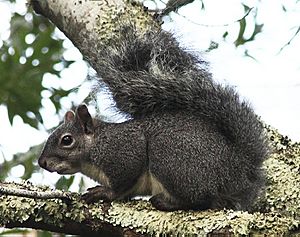Western gray squirrel facts for kids
Quick facts for kids Western gray squirrel |
|
|---|---|
 |
|
| Conservation status | |
| Scientific classification | |
| Genus: |
Sciurus
|
| Species: |
griseus
|
| Subspecies | |
|
|
 |
|
| Western gray squirrel's range | |
The western gray squirrel (Sciurus griseus) is a type of tree squirrel that lives in trees. You can find it along the western coast of the United States and Mexico. It's also known by other names like the silver-gray squirrel or the California gray squirrel.
There are three main groups, or subspecies, of western gray squirrels:
- Sciurus griseus griseus: Found from central Washington down to central California.
- S. g. nigripes: Lives south of San Francisco Bay to San Luis Obispo County, California.
- S. g. anthonyi: Ranges from San Luis Obispo to northern Baja California, Mexico.
Contents
What Does a Western Gray Squirrel Look Like?
The western gray squirrel was first described in 1818 by a person named George Ord. He used notes from the famous Lewis and Clark Expedition.
This squirrel is the biggest tree squirrel in the Sierra Nevada and Central California areas. It has feet that help it grip and climb. Unlike the eastern gray squirrel or the fox squirrel (which were brought into its home areas), western gray squirrels are quite shy. If they get scared, they usually run up a tree and make a rough chirping sound.
These squirrels can weigh from about 0.35 to 1 kilogram (0.77 to 2.2 pounds). They are about 43 to 61 centimeters (17 to 24 inches) long, including their tail. They are the largest native tree squirrel on the western coast of the United States.
Western gray squirrels have a special kind of coloring. Their back fur is a shiny silver-gray, like gunmetal, and their belly is pure white. Their tail might have some black spots. Their ears are big, but they don't have tufts of hair. In winter, the back of their ears turns reddish-brown. Their tail is long, very bushy, and usually curves upwards in an "S" shape.
Squirrels change their fur twice a year. In spring, they shed all their fur from head to tail. In fall, they shed from their rump to their head. Their tail hair only grows back in the spring. Mother squirrels sometimes use their tail hair to make their nests soft for their babies.
Western gray squirrels eat different kinds of food. They enjoy berries, nuts, many types of seeds, and even the eggs of small birds.
How Western Gray Squirrels Have Babies
Western gray squirrels can start having babies when they are about 10 to 11 months old. They usually begin breeding when they are around one year old. They mate over a long period, from December all the way through June.
Baby squirrels are born after about 44 days. The young ones, called kits, start to come out of their nests between March and mid-August. A mother squirrel can have one to five kits in a litter. The kits stay in the nest for a longer time than other types of squirrels. They grow slowly and won't leave the nest for six months or even more. This slower growth can be a disadvantage when they compete with other squirrels that grow up faster.
Young gray squirrels have tails that are not yet full and bushy. Their tails only become full when they are adults. This is a good way to tell how old a squirrel is. Mother squirrels can look very tired and stressed after raising their babies. When squirrels mate, they can be quite rough and sometimes bite each other. Female squirrels can also be very protective of their space and will chase other squirrels away, sometimes having strong fights.
Daily Life and What They Eat
Western gray squirrels live in forests, sometimes at high places up to 2,000 meters (6,500 feet) high. They spend time on the ground looking for food, but they prefer to move from tree to tree. They are active only during the day (this is called being diurnal).
They mainly eat seeds and nuts, especially pine seeds and acorns. They also eat berries, mushrooms, and insects. Pine nuts and acorns are very important foods for them because they have a lot of oil and some carbohydrates. These nutrients help them build up body fat, which is important for energy. They mostly find food in trees and on the ground. They usually look for acorns, pine nuts, new tree buds, and fruits in the morning and late afternoon. They eat pinecones and many other nuts to get ready for winter.
When a western gray squirrel senses danger, it spreads its tail out wide. This creates a kind of umbrella that can hide them and protect them from predators flying overhead. They are "scatter-hoarders," which means they hide many small amounts of food when there's a lot available. By doing this, they help spread the seeds of the trees they eat from. Even though squirrels are good at finding their hidden food, some caches are never found again. These forgotten seeds can then grow into new trees in the spring.
Western gray squirrels do not hibernate (sleep through the whole winter). However, they do become less active when it's cold. Like many animals that are hunted, they listen for alarm calls from other squirrels or birds to know if it's safe. When one squirrel makes an alarm call, others nearby will join in. Soon, the trees can be filled with the loud chirping sounds of many squirrels.
Tree squirrels are hunted by animals like bobcats, hawks, eagles, mountain lions, coyotes, cats, raccoons, and even humans.
Where Western Gray Squirrels Live and Sleep
Squirrel nests are called dreys. You can see them in trees. They are built from sticks and leaves, often wrapped with long pieces of grass. Western gray squirrels make two main types of stick nests:
- The first is a large, round, covered nest. They use this for winter, for giving birth, and for raising their young.
- The second type is more like a "sleeping platform." This is a simpler base they use for a short time or during certain seasons.
Both types of nests are made with sticks and twigs. They are lined with soft materials like leaves, moss, lichens, and shredded bark. The nest where babies are born might even be lined with the mother's tail hair. These nests can be quite large, measuring about 43 to 91 centimeters (17 to 36 inches) across and up to 46 centimeters (18 inches) deep. They are usually found in the top third of a tree.
Young squirrels or squirrels that are traveling might also "sleep rough" when the weather is good. This means they just balance spread out on a tree branch high above the ground. They also do this to cool down when it's hot, similar to how raccoons sometimes behave.
The Western Gray Squirrel needs lots of trees because it travels from tree to tree. It lives in wooded areas where it can build its complex nests. You can find them in high and low places in California, living in walnut trees and black oak trees.
Even though many animals hunt the Western Gray Squirrel, like Red-tailed Hawks, Great-horned Owls, eagles, Bobcats, Coyotes, Cougars, and even pet cats and dogs, these predators don't usually control how many squirrels there are.
Challenges for Western Gray Squirrels
In Washington state, the western gray squirrel was listed as a threatened species in 1993. Their numbers have not fully recovered from problems in the past. They face several threats:
- Habitat loss: Their homes are disappearing because of cities growing, big wildfires, and forests being damaged by too much fire control or animals eating too much grass. This also lets plants like scotch broom invade their areas.
- Road-kill: Many squirrels are hit by cars on roads.
- Disease: A disease caused by tiny mites, called Notoedric mange, can spread quickly among squirrel groups and cause many of them to die.
Other types of squirrels, like eastern gray squirrels, fox squirrels, California ground squirrels, and wild turkeys, are spreading into the western gray squirrel's territory. These other species compete with the western gray squirrel for food and homes.
In some parts of California, the western gray squirrel has disappeared completely. In southern California, you mostly find them only in the mountains and nearby communities. Experts say that eastern fox squirrels were released in cities like Los Angeles in the 20th century. These fox squirrels were brought as pets by veterans from the Mississippi Valley. These more aggressive fox squirrels pushed the shy western gray squirrels back into the mountains, where there was less competition. This introduction of a non-native species seems to be the biggest threat to the western gray squirrel in southern California.
See also
 In Spanish: Ardilla gris occidental para niños
In Spanish: Ardilla gris occidental para niños
Images for kids



